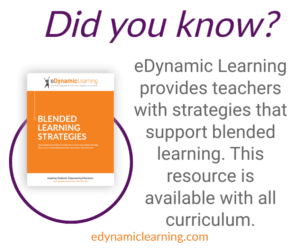
5 Effective Blended Learning Strategies
November 13, 2019There are many different types of effective blended learning models available to schools today, making it extremely flexible to implement. Once you’ve determined the type that works best for your program, it is important to consider the strategies you’ll use to combine both face-to-face instruction and online learning.
Searching for effective blended learning strategies can be a time-consuming task, but we know how important they are. Blended learning strategies develop students’ mastery of learning objectives while increasing student engagement, interaction, collaboration, and the use of digital learning tools.
Blended Learning is defined as having three components:
- Instruction delivered partially online, with some element of student control over time, place, path, and/or pace.
- Instruction delivered partially at a supervised brick-and-mortar location
- An integrated student learning experience is taking place
Many educators are already leveraging blended learning in their classrooms. However, it’s worth noting that blended learning is different than – and not to be confused with – a “tech-rich” learning environment. According to blendedlearning.org, “Technology-rich instruction shares the features of traditional teacher-led instruction with technological enhancements. This includes electronic whiteboards, digital textbooks, online lesson plans, Google Docs, virtual reality, and so forth. These tools may enhance learning experiences, but do not fundamentally shift instruction in a way that gives students some element of control.”
A Blended Learning Classroom Example
Let’s look at an example by checking out what Mr. Hubbard does in his science classroom that differentiates his instructional strategies to meet the needs of a blended learning classroom versus a tech-rich classroom. The below example is based on how he introduced students to the concept of force and motion.
- Mr. Hubbard first assigned a short ‘direct instruction’ video for homework, that introduced his students to the concept of force and motion. This video was watched outside of his core classroom time before the students were active participants in the lesson itself. This video introduced his students to this new concept. He asked his students to jot down notes, questions, ideas, etc., that they experienced while watching this new concept video and bring them back to class with them the next day.
- The next day in class, Mr. Hubbard had different ‘stations’ set-up for the kids to explore in collaborative groups where they extended their learning in a variety of concept (and topic) related activities.
- Students explored the concept of force and motion further in a hands-on experiment activity.
- Another station was set up for small group time with Mr. Hubbard where he went over the questions that students wrote down in their science journals while watching the direct instruction video. He used this time to really encourage students to think critically and problem-solve. He even had an example problem at his station in which he asked students to think about how to solve based on their introduction to the concept. This opened up a huge conversation with students and Mr. Hubbard was able to identify gaps – and accelerants – in the students’ thinking and understanding of the concept, which allowed him to make decisions on next steps for instruction for the next lesson.
- Another station allowed students to further explore the concept in a different hands-on experiment.
- The last station required students to read an online digital lesson on force and motion
In this example, Mr. Hubbard was employing a combination of blended learning implementation models of flipped classrooms and station-rotation.
If Mr. Hubbard were to make his classroom “tech-rich,” he could employ strategies such as:
- Submission of documents digitally (Google, Dropbox, etc.)
- Creation of Powerpoints, videos, podcasts, etc., as a form of presentation or culminating activity
- Using Adobe Suite software to create products to demonstrate knowledge
- Photo collages to document steps and outcomes in STEM class activities
When we “blend” our in-class learning activities with those that we leverage online learning, we not only are implementing blended learning strategies, but we are additionally getting our students engaged in learning and preparing them with the skills they need for college and career.
Blended Learning is the equation of online learning + face-to-face learning = blended learning!

Blended Learning Strategies
eDynamic Learning recognizes the importance of offering effective blended learning strategies to use with our curriculum. This is why our Teacher Resources includes a Blended Learning Strategies guide alongside a Pacing guide and Project-Based Learning guide. These teacher resource materials accompany all career and technical education (CTE), electives, and Career Ready Program™ courses.
 Below are just a few strategies from our Blended Learning Strategies guide. These strategies help develop the skills students need for college and career readiness, including academic language, higher-order thinking skills, content-area literacy skills, technology skills, notetaking strategies, and soft skills. Furthermore, strategies included in our full edition of our Blended Learning Strategies guide,
Below are just a few strategies from our Blended Learning Strategies guide. These strategies help develop the skills students need for college and career readiness, including academic language, higher-order thinking skills, content-area literacy skills, technology skills, notetaking strategies, and soft skills. Furthermore, strategies included in our full edition of our Blended Learning Strategies guide,
- address different learning styles,
- integrate multiple modalities, and
- are differentiated to address diverse students’ needs, including English language learners and special education students.
In addition to the blended learning strategies that support face-to-face and/or online learning, engaging digital course features such as podcasts and videos can truly bring blended learning to life and support a variety of blended learning implementation models.
The following methods benefit both face-to-face and online learning; they suit a variety of blended-learning models; and they easily integrate into any course unit or lesson.
1. Collaborative Learning
Strategy Overview
- What Is It? Collaborative thinking encourages students to brainstorm together and share what they know about concepts by responding to questions or discussion topics as part of cooperative groups.
- When Do I Use It? Why Do I Use It? Use collaborative learning before starting a lesson or reading a text to activate prior knowledge and effectively build background learning. It’s also useful after a lesson when students can apply learning or extend their thinking. In addition, it’s an effective way to initiate project planning before starting a project or lab.
2. Frontloading Vocabulary
Strategy Overview
- What Is It? Frontloading vocabulary is a means of teaching unit vocabulary, course-specific terms, and key academic vocabulary in a step-by-step process. It’s a process that teaches students to generalize and apply these words in a variety of contexts.
- When Do I Use It? Why Do I Use It? Apply this strategy (1) prior to starting a course unit, (2) as part of an introduction to a lesson, (3) as students need to understand and use the terms, or (4) at the end of the lesson, after students have explored and constructed meaning of a course topic or concept. A purposeful introduction to key vocabulary makes the course content more comprehensible, and students engage with course material in a more meaningful way. It also develops students’ academic language and their capacity to use the course-specific terminology in all tasks.
3. Translating the Text
Strategy Overview
- What Is It? Students put into their own words key sentences from the course text that include complex academic language.
- When Do You Use the Strategy? Why Do You Use the Strategy? This strategy can be used during the reading or listening process, or to analyze the text after students have finished reading or listening. This strategy develops students’ ability to comprehend and interpret complex academic and course-specific language. It also helps them develop a deeper understanding of course concepts.
4. Visualize-Represent-Share
Strategy Overview
- What Is It? In this strategy, students create a visual representation for a section of the text related to a lesson or course concept.
- When Do I Use It? Why Do I Use It? Use this strategy during or after the lesson’s reading. It can also be applied after instruction for a lesson concept has been completed. This strategy supports visual learners and further develops all students’ ability to visualize the text.
5. Discussion Points
Strategy Overview
- What Is It? Discussion Points is an accountable talk strategy that ensures all students participate in group discussions. Students share their responses to course discussion questions and discussion topics and earn points each time they participate.
- When Do I Use It? Why Do I Use It? This strategy can be used with the course Text Questions, course Discussion prompts, or other discussion topics or questions. Discussion Points can be included as part of the before, during, and after phases of reading or listening to the lesson text. It engages students in discussion and deepens their understanding of unit objectives while acquiring course and academic language.
Get in Touch!
Are you ready to incorporate blended learning in your classroom or school program? eDynamic Learning not only provides schools with the largest library of career and technical education (CTE), elective, and Career Ready Program™ courses in the industry for grades 6-12, but also provides teachers with a Blended Learning Strategies guide (and Project-Based Learning guide) to engage students in strategies that promotes engagement, enthusiasm, and deeper learning. Get in touch with us today to learn more!
Check it Out!
Check out our on-demand webinar: Blended Learning with eDynamic Learning Courses
In this brief webinar, you’ll:
- get a high-level overview of some of the most popular blended learning implementation models
- learn how you can incorporate a blended learning model into your teaching strategies
- see how eDynamic Learning courses come to life and enable deeper learning through blended learning
——————
View All Blogs

